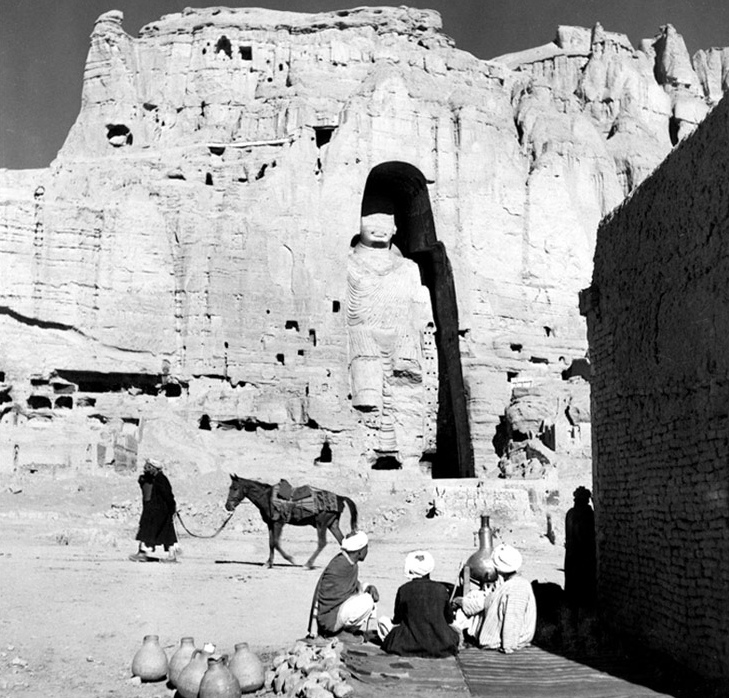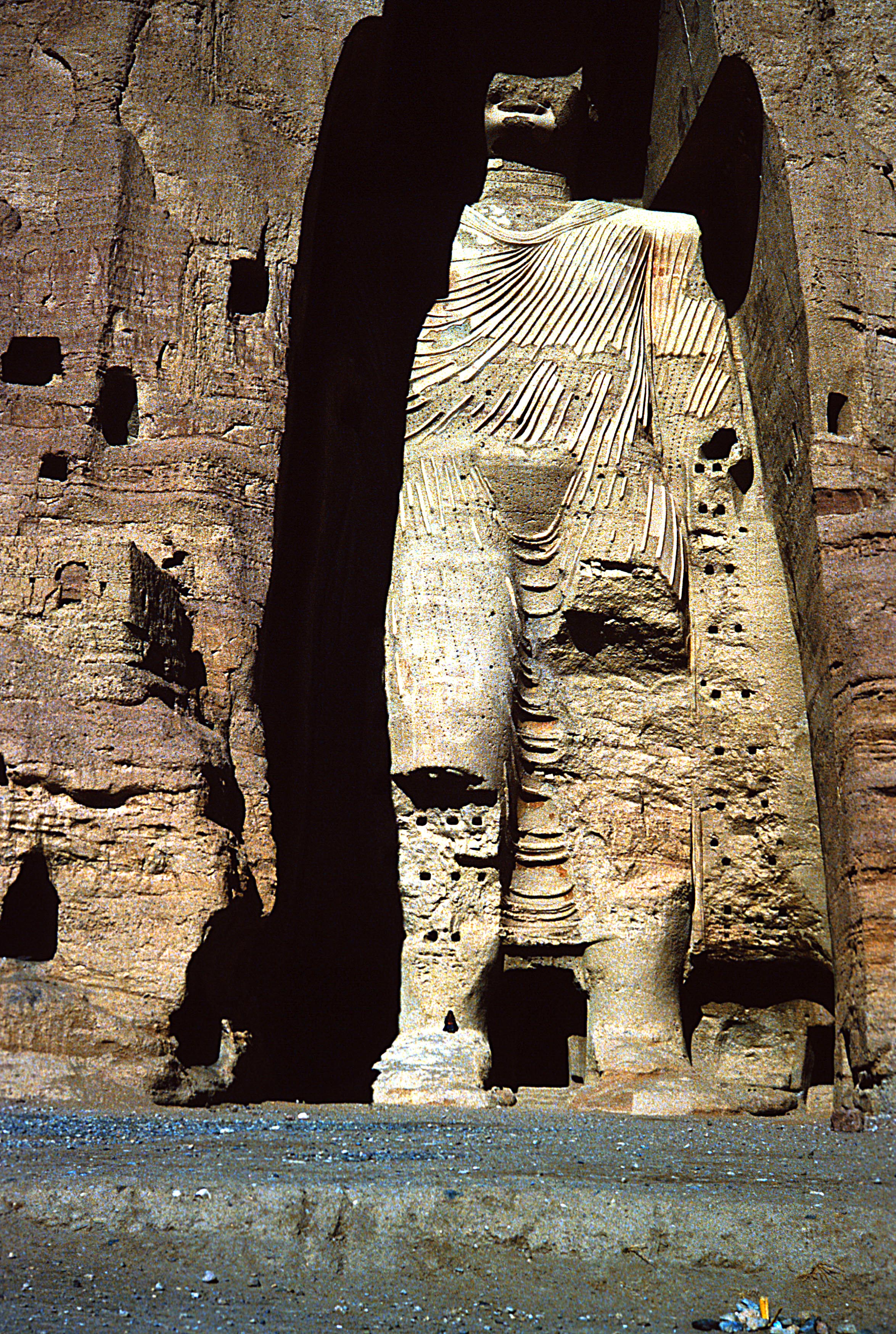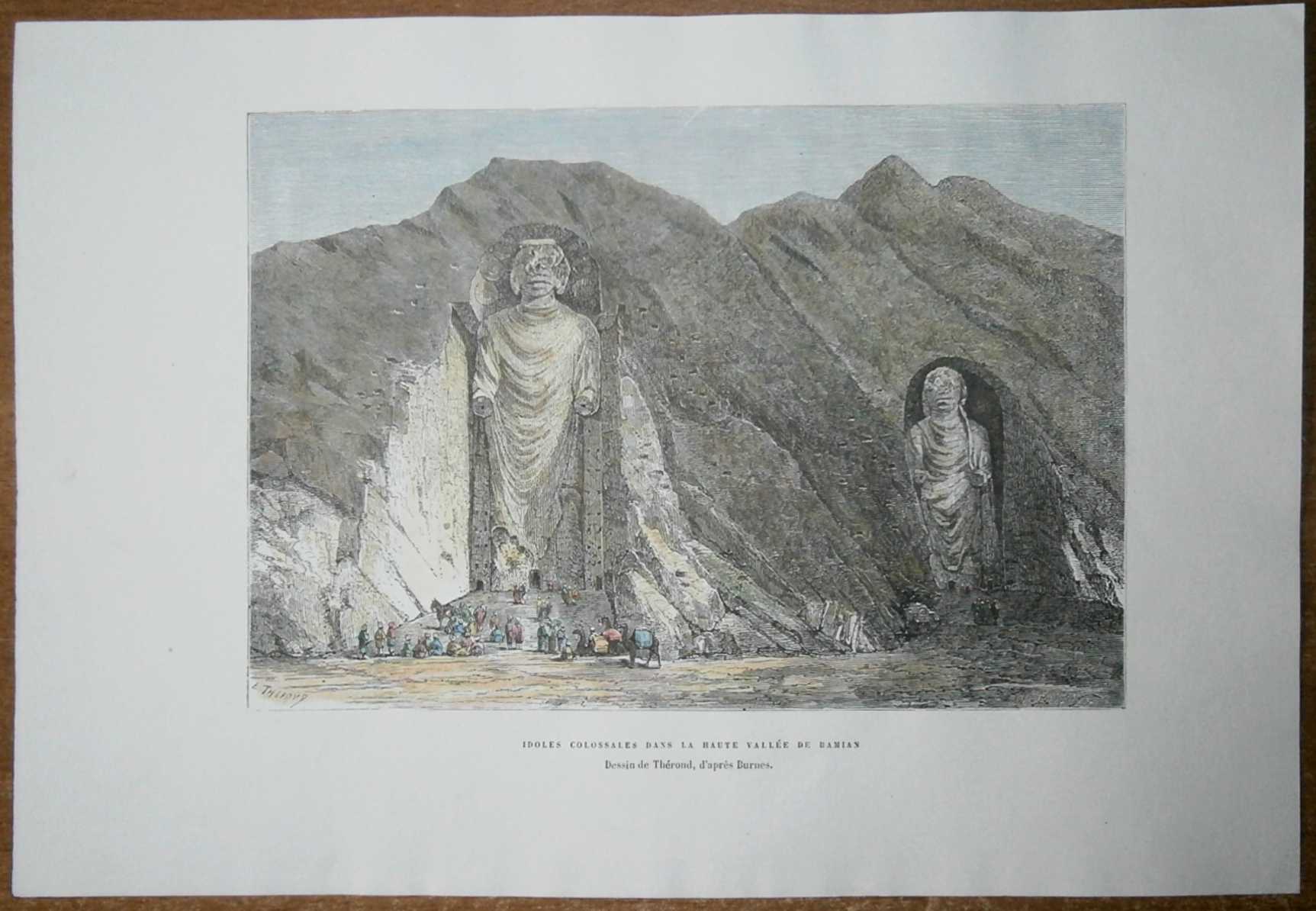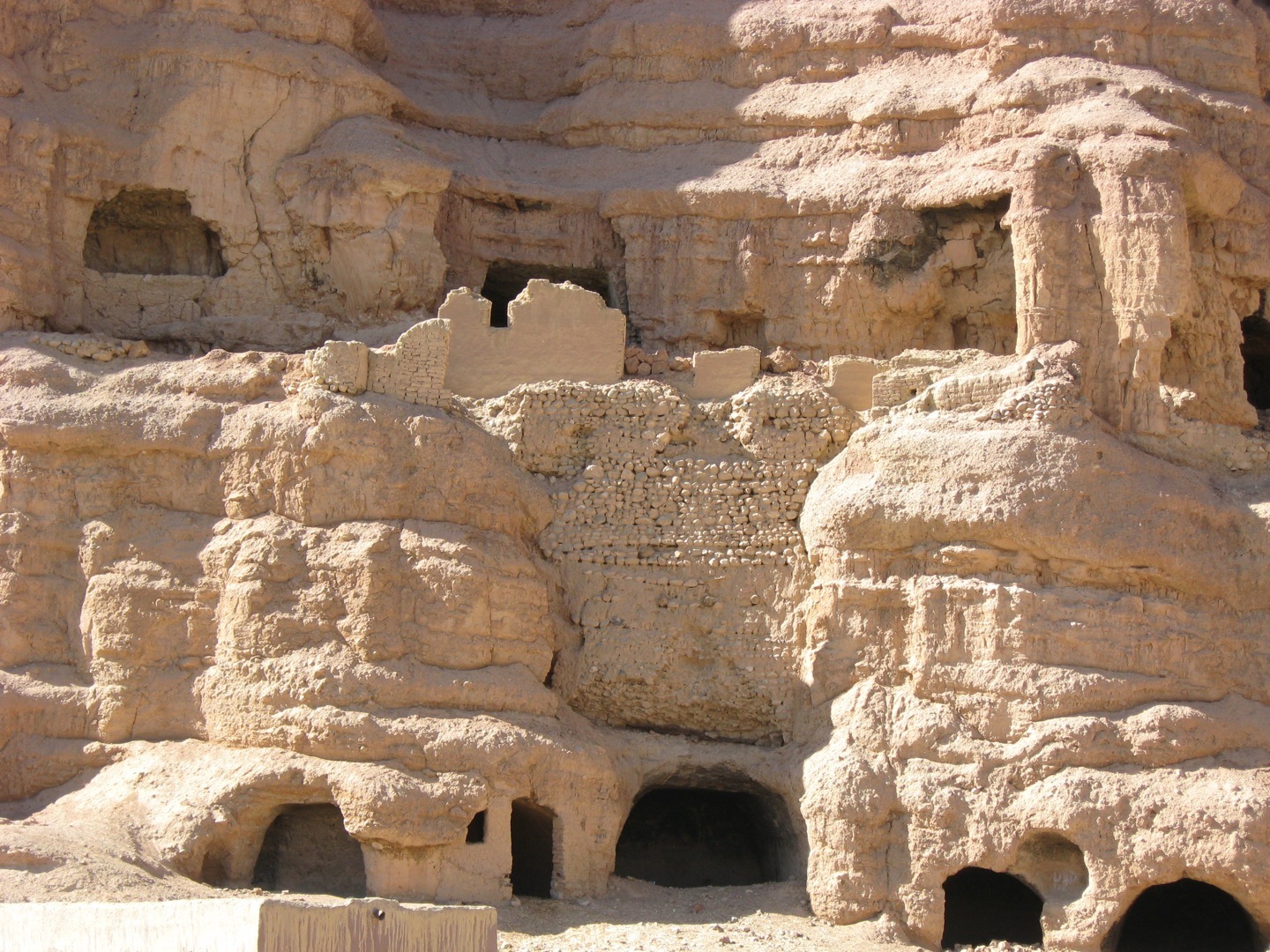Bamiyan Buddhas

Bamiyan Valley is located in the central part of Afghanistan, less than 200 kilometers north-west of Kabul. In the valley there is a modern city of Bamiyan - the center of the same name province of Afghanistan.
Valley is the only easy passage through the Hindu Kush, so since ancient times served as trade corridor.
In the II century there arose Buddhist monasteries. During the reign of Ashoka began construction of the giant statues that ended only after two years. In the V century Chinese traveler wrote about ten monasteries and thousands of monks who inhabited. Extensive cave complexes carved into the rock served as an inn for pilgrims and traders. In the XI century the valley was annexed to the Muslim Ghaznavid state, but then Buddhist shrines were destroyed. In the valley of the city grew Gaugale decorated with beautiful mosques.
In 1221, the armies of Genghis Khan destroyed the city and devastated the valley. In the Middle Ages, a complex of Buddhist monasteries in the Bamiyan Valley was named Kafirkala - a city of infidels.

Unique are the two giant Buddha statues that were part of a complex of Buddhist monasteries in the Bamiyan Valley. In 2001, despite the protests of the international community and other Islamic countries, the statues were vandalized by the Taliban, I think that they are pagan idols and must be destroyed.
The statues were carved in the rocks surrounding the valley, partly supplemented by solid plaster holding a wooden armature. Made of wood upper part of individual sculptures have been lost in antiquity. In addition to the destroyed statues in the monasteries of the valley there is another showing the reclining Buddha, its excavation began in 2004.

Coordinates: 34.716667, 67.834 ° 43 's. sh. 67 ° 48 'east. e. / 34.716667 ° c. sh. 67.8 ° c. h.
By the way, these statues are often transferred to the invasion of hostile people to Buddhism. The first time the valley emptied of Genghis Khan, and the second time it was annexed by the Muslim Ghaznavid state, but in the first and in the second case the conquerors left giant sculptures intact.

According to the description of travelers who have visited the Bamiyan Valley with Ipo Xvv glitter gold ornaments that covered the statue of Big Buddha dazzled eyes, folds of clothing, in contrast to the very figure, carved out of the rock, made of plaster and stone sculpted over the image on top of the molten metal enrichment pokrytykraskoy ( probably bronze). Drape dress was made by a unique technology, so when the wind came the jingle. 1500 years, Buddha statues and rock sanctuary of Bamiyan were the personification of fame, luxury, stability and prosperity in Afghanistan during its heyday and harmony with its neighbors.

Until the 3rd century, Afghanistan was the ancient Bactria, a province in the composition of the Persian Achaemenid Empire. Bactria later joined the Kushan Empire. Passing through the Silk Road, Afghanistan contributed to the spread of Buddhism from India to the region in the first century AD.

And in Kushans patronized the arts and religion, which is why there was the introduction of a Bactrian Buddhist style, which until then was influenced by Hellenistic art.
Islamism was introduced to Bamiyan in the 11th century AD, when the central part of Afghanistan was under the rule of Sultan Mahmud Chazna (998 - 1030). A city Dzhuldzhul (Bamyan) have to adjust the pattern of Khorasan region of Iran.

As a consequence there were walls, towers, forts, earthworks and the citadel. In the early 13th century, Genghis Khan's army destroyed the city of Bamiyan to the last stone and ransacked Buddhist monasteries. Not only touched the statue of Buddha. In the 17th century Mughal Emperor Aurangzeb ordered his army to shoot off the legs of Big Buddha.

Valley had already been abandoned. It was only in the mid-19th century, the caves became populated and used as shelters for pets. In 1979, in the town of Bamiyan were about 7000 inhabitants.

In the 1970 -1980 years of the valley was used by the Soviet military.
The Chinese traveler, Xuanzang, who visited Bamiyan around 630 AD, described not only the two standing Buddhas, but also the temple in the distance from the Royal Palace, where the reclining Buddha measuring about 1 thousand. Feet. Many experts believe that he was lying on the ground and destroyed long ago. But two archaeologist Zemaryalay Tarzi of Afghanistan and Kazuya Yamauchi of Japan, diligently conduct excavations in the hope of finding its base. Tarzi, who excavated Buddhist monastery may have also found the wall of the royal palace which could lead to a third Buddha. "History of the Bamiyan first begin to dig in the literal sense, and by the restoration work, and by the archaeological site," - said Kasak Maeda, a Japanese historian who has studied Bamiyan over 40 years.

The most striking finding was the ark, in which there were three clay beads, leaf, clay seals and fragments of Buddhist text written on bark. It is believed that the ark was placed on the chest of the larger Buddha and plastered in construction.

In 2001, the large Buddha statues were destroyed by the Taliban. When the Taliban and their patrons of the "al-Qaeda" were at the zenith of power in Afghanistan. Action, pursuant to the decree of the destruction of the "gods infidels" best effort. This happened in March, the operation was carried out for two weeks. Initially, the statues were shot a few days of 2 anti-aircraft guns and artillery, and then in a niche at the base were laid anti-tank mines, and finally neskolkomestnyh Hazara people, lowered on ropes down the rock, where they laid the explosives at the base and the shoulders of the two Buddhas and broke the statues on pieces.

Here's how to write about the witnesses:
Mirza Hussain and other prisoners worked for hours, laying mines, bombs and dynamite at the foot of the most beautiful art work in Afghanistan - 55-m statue of standing Buddha carved into the sandstone cliff in the Bamiyan Valley in about the 7th century. When the work was completed, a local Taliban commander gave a conventional sign, and hundreds of observers closed their ears, detained their breath in anticipation of the fall of the Buddha. However, this did not happen. The first charge of explosives only destroyed the legs of the statue. "They were very disappointed," - says Hussain, referring to the Taliban leaders, who in March 2001 decided to decree that the famous Buddhist monument is idolatrous, and therefore must be destroyed.
P ervonachalno, Taliban fighters shot at the Buddha of machines, MANPADS and RPGs, but the damage was minimal. After the explosion at the base of the statue has not brought results, Hussein with other prisoners were hung on the edge of the cliffs to stuff dynamite holes in the soft rock. "Our soldiers are working hard in order to destroy the remaining parts - so said at a press conference in Kabul, held the day after the explosion, Molo Kadratalla Jamal, the Taliban Minister of Information and Culture. - It is easier to destroy than to rebuild. "

He was right. Within a few days the Taliban almost destroyed the remains of the mighty Buddhist civilization that ruled for six centuries this strategic valley at the crossroads of trade tsentroaziatskoy. They looted the cave in the cliff of Bamiyan, smashing thousands of smaller sculptures of Buddha. They cut off filligrannye murals on the walls, and where they have not been able to cut off the plaster, they knocked out the eyes and hands of the people depicted. Locals say that the figures in the images had features typical of Hazaras persecuted Shiite minority that inhabits this area. After taking control of the Taliban of Afghanistan were destroyed hundreds Hazaras; many in the valley believe that the destruction of the Buddhas was an extension of their campaign aimed at genocide. "The eyes of the Buddha were like the eyes of the locals and the Taliban destroyed the statues as well as tried to kill us, - says Marzia Mohammadi, a midwife. - They wanted to kill our culture and wipe us in this valley. "

Seven years, archaeologists and volunteers from around the world have done everything in their power to rejoice these symbols Bamiyan Buddhist heritage. Piles of ruined stones were piled in the shelter of corrugated iron and plastic, and built where once stood the Buddha. Now scientists are arguing whether the statue to be restored and if so, how. After quite a bit of authentic stucco and stone survived. Folding together again would be related to folding puzzle consisting of millions of pieces - but without the original image printed on the cover. However, Habiba Sarabi of Bamiyan, believes that the restoration of the Buddhas, it is important for the psychological climate in her area. "Buddha was a part of the lives of people in Bamiyan, - she says. - Now the empty niches of the Buddhas affect the landscape, suppressing the people. "

In a process called "assembly", the original fragments of the damaged sculpture can be mixed together with cement, or other materials - as was done in ancient Cambodian temple complex of Angkor Wat. However, according to experts on the upgrade if remains less than half of the original material, the new structure loses its historical value, and considers only an exact copy. Restoring an exact copy can permanently delete Bamiyan Buddhas from the list of UNESCO World Heritage. Archaeologists estimate that the remaining approximately 50% of the original stone, but more will be conducted over a full investigation.

Abdul Ahad Abassi, head of the restoration and conservation of historical monuments in Afghanistan, sees a certain pattern in the efforts of the Taliban to destroy the Buddhas. One of the early Islamic kings of Afghanistan erupted in the 11th century in the cave, smashing idols. At the end of the 19th century, the mother of King Abdul Rahman shot standing Buddhas of guns. Afghan history, he said, is filled with individuals who have tried to erase the past. However, they are also part of the heritage of Afghanistan - the legacy he is obliged to work to maintain. Despite all zverskost, a legacy of the Taliban - an important part of the recent past in Afghanistan.
Empty niches of Bamiyan - a reminder of the brutality of which can not be forgotten - the restoration of the Buddhas would be a kind of erasure of memory. "The current state of the Buddhas - in itself an expression of our history - says Abassi. - No matter how good or bad was the Taliban, we can not pull out this page from the book. "

Governor Sohraby sees Solomonic decision to try on the recent history of Afghanistan and its ancient culture. "We have a number of empty niches, it is enough to recall the dark pages of our history, - she said. -Vosstanoviv A Buddha, we can leave the other destroyed. "

A team from the University of Munich (Germany), made a statement on the principal possibility of reconstruction of one of the Buddha statues in the Bamiyan Valley, Afghanistan, the Taliban bombed in 2001.
The world-famous sculptures (one height of 53 m, and the second - 35 m)
never stopped anyone for a thousand years, until the Islamists did not
consider them "disgusting manifestation of idolatry."

Originally, the sculptures were painted in a nice looking colors: dark blue, pink, orange, red and white. Here are the state of the statues at the end of the X century. Also shown are consequential damages. (Illustration Arnold Metzinger.)
Meticulously examining hundreds of fragments of statues, the
researchers, led by Professor Erwin Emmerling came to the conclusion
that a smaller statue be restored. As for the second, the depth (thickness) which reached 12 meters, scientists are skeptical.
But the revival of the 35-meter statue will not be easy mezhdudelem.
Even if we do not take into account the political and other external
difficulties, the practical implementation of this good intention is
associated with a number of difficulties.
Will either have to build in the Bamiyan Valley, special production, or
figure out how to carry 1,400 fragments weighing about 2 tons each in
Germany.
Moreover, according to the scientist, the decision must be taken as
soon as possible, because the sandstone from which the statues were
carved, very fragile, and the wreckage, despite all efforts to preserve
them, in a few years will lose a form suitable for the recovery of the
statue.
As for most of the statue (55 meters high), Emmerling said that she
acted in sharper relief the cliff, which was cut, and therefore more
affected by the explosions. Scientist questioned the possibility of its recovery.
One of the results of European and Japanese scientists in Bamiyan will
be to create a three-dimensional model of the Buddhas in their original
form.
Researchers, in particular, found that after the construction of the
statues were brightly painted, and later color several times renews.
In addition, the group Emmerling by mass spectral analysis clarified
dating creation of statues smaller - between 544 and 595 years, large -
between 591 and 644 years (Muslim calendar, in which lived the Taliban
destroyed the statues, starting with 622).
There is evidence, however, that some Japanese Buddhists have agreed to allocate money for the project, whatever it may be. More detail it will all be discussed at a special conference in Paris this week.
We add that in passing the German scientists dated smaller Buddha 544-595 years, and its large counterpart - 591-644 th.

And here's another interesting project:

The Government of Afghanistan has also approved a proposal by the Japanese artist Hiro Yamagata to establish a laser-sound installation cost of $ 64 million, which would show images of the Buddhas of Bamiyan and would result in the movement of hundreds of wind turbines while supplying electricity to the surrounding residents.

There is such a theory of the emergence of these statues:
Devoted to the works of the Atlanteans who moved to Central Asia after the sinking of Atlantis, the model was created five root races in the scale of 1: 1 in the form of statues, carved in the rocks. These statues are in today's Afghanistan, the Bamiyan Valley. In The Secret Doctrine by HP Blavatsky are naitochneyshie description of this model of five root races. It is worth to fully bring this quote
"... About Bamyanskih statues. What is this and what is the statue of the area in which they stood for countless ages, confronting disasters, commits around them, and even a man's hand, as for example, during the invasion of hordes of Tamerlane and warriors vandals Nadir Shah? Bamiyan represents a small, pitiful, dilapidated town in Central Asia, halfway between Kabul and Bal'om, at the foot of the Koh-i-Baba, a huge mountain chain Paropamiz or Hindu Kush, about 8500 ft. above sea level. In ancient times Bamiyan was part of the ancient city Dzhulzhul plundered and destroyed to the last stone of Genghis Khan in the XIII-th century. The whole valley is bordered by huge rocks that are full part of the natural and man-made part of the caves and grottoes, once the abode of Buddhist monks, based in them the Vihara. Similar Vihara found in abundance, and even now in the rock-cut temples of India and in the valleys of Jalalabad. Before some of these caves were discovered, or rather rediscovered in our century five huge statues that are considered to be images of the Buddha, for the famous Chinese traveler Xuan Zang said that he saw them when he visited Bamian in the seventh century.

A statement that around the globe there is no bigger statues, easily confirmed by the testimony of all travelers to explore and measure them. So, the biggest in 173 f. height or seventy feet above the "Statue of Liberty" in New York, as the latter is measured only in 105 f. or 34 meters in height. The very famous Colossus of Rhodes, between the legs of which were easily the largest ships of the time, there was only 120 to 130 f. vyshiny. The second big statue carved as well as the first in the rock, has only 120 f. or £ 15. Above this statue of "Freedom". The third statue is measured only at 60 psi., Two other even smaller, the last of them only slightly more than the average tall man of our present race.
The first and largest of these giants depicts a man draped in a sort of "toga". M. de Nadeylak believes that the general appearance of the statue, head lines, folds and especially the large pendulous ears are undeniable indications of what was intended to give an image of the Buddha. But in reality they are nothing like this prove it. Despite the fact that most of the existing figures of Buddha depicted in the state of Samadhi, have large pendulous ears, this is the only innovation of recent times and later thought. The original idea was taken from the esoteric allegory. Unnaturally large ears are a symbol of wisdom and omniscience have been mean and remind the power of the One who knows everything and hears everything, and from the goodness of love and care which all creatures, nothing can escape. As the verse: "Merciful Lord, our Master, hears the cry of the suffering of the smallest of the smallest outside the valleys and mountains and rushes to his aid."

Gautama Buddha was a Hindu, Aryan same approach to such ears is found only among Mongoloids, Burmese and Siamese, who as well as in Cochin, artificially disfigure their ears. Buddhist monks turned the grottos Miao-chieh in the Vihara and cells, came to Central Asia in the first century of the Christian era or so. Because Luan-tsang, describing the colossal statue, says that "the brilliance of gold ornaments that covered the statue" in his day, "dazzled the eyes," but from a gilt was gone today. The folds of clothing, in contrast to the very figure, carved out of the rock, made of plaster and stone sculpted over the image. Talbot, who has made the most thorough study found that the folds of these belong to a much later age.Because the statue itself should be attributed to a much more ancient period than the time of Buddhism. In this case, we can ask, Who do they represent?

again tradition, confirmed written records, answers this question and explains the mystery. Buddhist Arhats and Ascetics found the five statues and many more, now converted into dust. Three of them standing in the colossal niches at the entrance of their future abode, they covered the clay and over the old fashioned new statue, would be sure to portray Lord Tathagata. The interior walls are covered with niches to this day yarkoyu painting images of human and sacred image of the Buddha found in each group. These frescoes and ornaments - reminiscent of the Byzantine style of painting - are pious work of monks, hermits, as well as some other smaller pieces and ornaments carved in the rocks. But five figures belong to the creation of the hands on the Fourth Race, who, after the sinking of their continent, found refuge in the fastnesses and on the summits of the Central Asian mountain range.
Thus, five figures are indestructible record of the esoteric teachings of the gradual evolution of Ras. The biggest shows first Race of mankind, its etheric body was sealed in a solid unshakable stone for the edification of future generations, otherwise the memory of it will never have survived the Flood of the Atlantic. The second - 120 f. height - shows "Later-born"; and third - 60 f. - Race perpetuates the fallen and those who had conceived the first physical Rasu, born of father and mother, the last offspring of which is shown in the statues found on Easter Island. These were only 20 and 25 pounds. growth at a time when Lemuria was submerged, after it was nearly destroyed by volcanic eruptions underground fire. Fourth Race was even smaller, though gigantic in comparison with our present fifth race, and ends with the last series. "
End of quote.

So, if you convert feet (one foot = 30,479 cm.) In meters, then we obtain the following dimensions of each of the indigenous races:
Start the CD (self-born) - 173 feet = 52.7 meters.
The second KR (later-born) - 120 feet = 36.6 meters.
Third KR (Lemurians) - 60 feet = 18.3 meters
Fourth KR (Atlanta) - 25 feet = 7.6 meters.
Here it should be noted that the shape of the body and the garment carved figures of the first two races may not coincide with the real bodies of the first and second root-race, because According to Blavatsky, these statues were in our era caked with plaster to create an image of the Buddha. But apparently only need to take into account the dimensions of the bodies of the first two statues. Also not clear which periods of root-race in question - can subraces of the first, and perhaps of the latter. But it is not so important. The main thing is to understand the principle, saying that indigenous race has been in decline in its growth, and that the lowest point has already been passed by mankind in the past centuries. Now the vector of physical development is aimed at a return to the previous size, which can be seen today at least by increasing the average increase of the modern average person.
We must assume that this trend will continue - physical people will be higher following centuries people today. And if you look much further - to the end of the sixth root race, when the representatives of the last subraces sixth root race will be translated into the astral body of compacted, it can be assumed that they will be comparable to the first Lemurian races (18 meters), which was about the same poluefirny- semi-tight and compacted as the astral plane. This assumption is supported by the fact that the next root race - the seventh - will be their evolution over a much larger planet than Earth - Neptune, where the large size of the body just needed to somehow adapt to the enormous size of Neptune.

Clickable



No comments:
Post a Comment